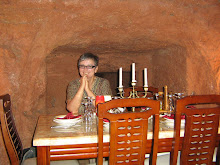
My friends and relatives in Australia started a few hours before me, my friends and relatives in UK were nearly the same time and my friends and relatives in USA were a bit behind, but we're all into 2009 now so I hope everyone manages to find whatever they are looking for in this bright new year.
Here in Marsaxlokk, it's a bright, sunny start to the year but cold. I will go out walking this afternoon to get warmed up.
My last walk for 2008 was to Delimara point, the headland that marks the northern border of Marsaxlokk harbour. It's amazing that I've left it this long to discover it but I assumed that it was now dominated by the Enemalta chimney and fuel tanks located at the edge of the bay so whenever I walked up over the ridge towards Marsascala and St Thomas Bay, I by-passed the country road leading towards the point.
Yesterday I decided to explore. I'm glad I did! Once I got past the Enemalta power plant which is not as dominant as it is on the Birzebbugia side because it is built down inside a quarry, I discovered a dramatic headland with another Maltese story etched on the landscape. The photo that heads the post is of the light house that now stands towards the end of the peninsula and staffed by a surveillance branch of the army.
Delimara got its name from the lighthouse - Dejr l-Imnara in Malti means lantern house. It was built in 1855 which is recent in Maltese history. Before that, at the time when the soldiers of Suleyiman the Magnificent sailed into Marsaxlokk harbour in 1565 there was nothing to mark this peninsula that stands between the Straits of Sicily and the largest harbour in Malta (yes, Marsaxlokk is bigger than Grand Harbour).
The knights built some fortifications at the end of the peninsula in 1770s (earlier batteries and forts, including fort St Lucjan were built prior to this in the 17th century) but no lighthouse was put up for fear of making it easier for further invasion. The British then built fort Delimara nearby in 1880 and this now straddles the end of the peninsula with a ditch all around and sloping fortified walls. At the seaward end, the globigerina limestone from which it is made has been weathered dramatically.
At that point, I had a phone call from my friend Celia to wish me a happy New Year and we chatted for so long that when I continued the post and pressed to publish I found that I was no longer on line so lost the end of yesterdays walk. So this is a re-run!
What struck me most about Delimara point were the sea and landscapes that have been etched by the culture of Malta over the centuries. At the end of the peninsula there are salt pans rippling silver in the afternoon sunlight, waves surge around the rocks at the foot of the cliff and the circles of the fish farms mark the undulating sea further out. On the land there are the familiar terraced fields with rubble walls and the hunting hides with stone bird tables. What was new to me in a couple of places near to hides were what looked like cricket wickets surrounded by bird tables. It took me a while to work out that they were cleared ground where the bird trappers would put up their nets ready to pull the string and drop them on the birds that came down in response to the calls of the caged birds on the tables. Now that bird trapping has been banned in this brave New Year, I imagine that these cleared areas will gradually be reclaimed into the landscape.
There is also a lovely rocky bay on the seaward side of the peninsula and it looks like there are walking tracks that go around the cliff there so I determined to make that my first walk for 2009. I've just got back from that walk and will write about that in my next post.

No comments:
Post a Comment